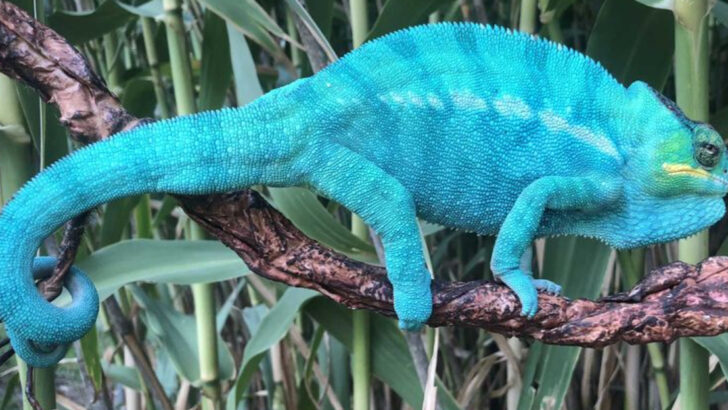They don’t just change colors—
they are the colors.
Chameleons are nature’s most dramatic little show-offs, and some of them look like they’ve crawled straight out of a tie-dye fever dream. Electric blues, screaming reds, and greens so intense they could glow in the dark—these reptiles don’t believe in being subtle.
And yet, most of the world has never laid eyes on their rarest forms. We’re talking about wild beauties that live in the misty trees of Madagascar, high-altitude African mountains, and forest patches so hidden, Google Maps shrugs.
Some are tiny, some are giants, and all of them are downright dazzling.
This isn’t just a lizard list—it’s a color explosion waiting to happen.
Let’s meet the 18 most jaw-dropping, rainbow-wrapped chameleons you’ve (probably) never seen.
Panther Chameleon
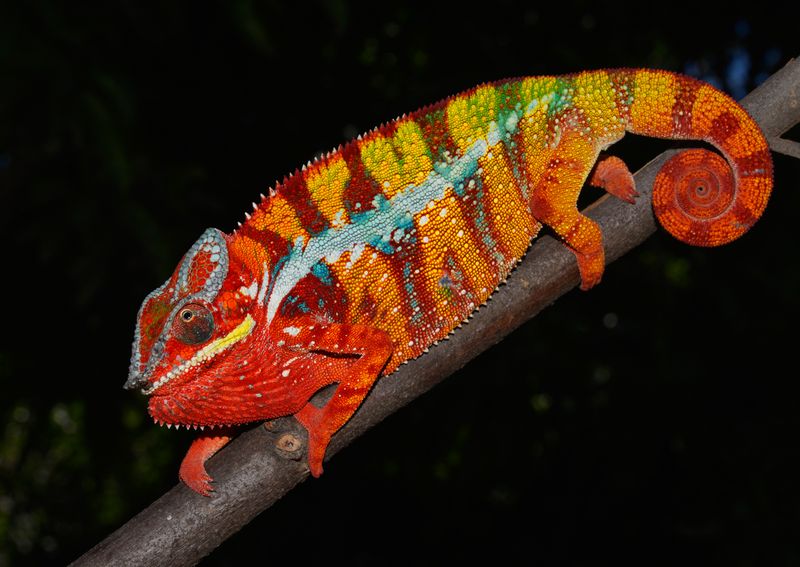
Meet the Panther Chameleon, a true artist of the animal kingdom. With its dazzling palette of reds, greens, and blues, it looks like it has just stepped out of an impressionist painting. Found primarily on Madagascar’s northern tip, its ability to change color is legendary.
In the lush rainforest, it uses this skill to communicate, assert dominance, or blend seamlessly into its surroundings. As you watch it move, its skin seems to ripple like a living canvas, captivating all who gaze upon it. The Panther Chameleon’s charm is undeniable, making it a favorite among reptile enthusiasts.
Nosy Be Chameleon
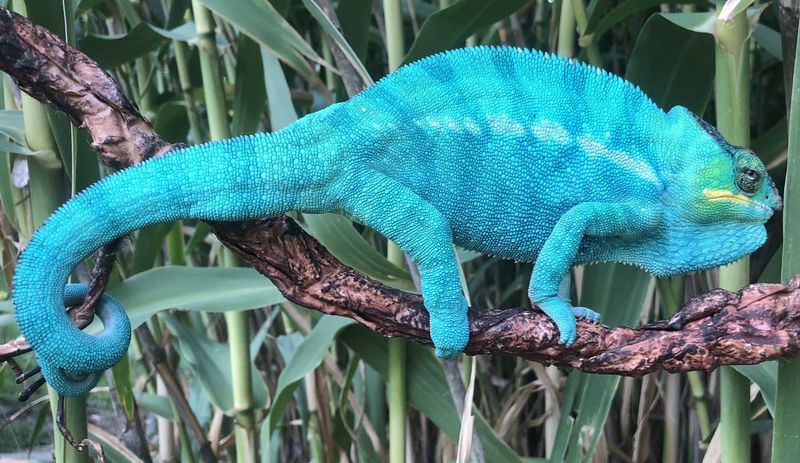
The Nosy Be Chameleon is a burst of electric blue, making it look like a miniature sky come to life. Native to the island of Nosy Be off Madagascar’s coast, this species thrives in humid, tropical habitats.
Its striking color isn’t just for show; it helps the chameleon blend into the blue skies and lush foliage. Their eyes, moving independently, scan the landscape for insects, a reminder of their acute awareness and hunting prowess. The Nosy Be is not just a visual spectacle but a testament to nature’s creativity.
Parson’s Chameleon
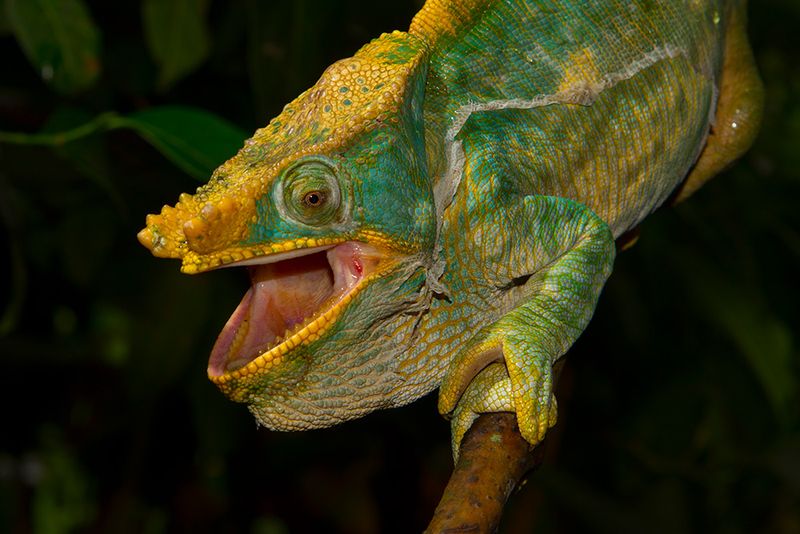
The Parson’s Chameleon is a giant among its peers, both in size and presence. Its impressive girth, coupled with vibrant green and yellow hues, makes it a dazzling sight. Hidden in Madagascar’s dense forests, it’s a master of disguise.
This chameleon sports a unique casque on its head, adding to its grand appearance. As it moves slowly through the trees, its colors shift from vibrant greens to mellow yellows, reflecting its mood. Observing a Parson’s Chameleon is like witnessing a slow dance of colors in the wild—truly mesmerizing.
Jackson’s Chameleon
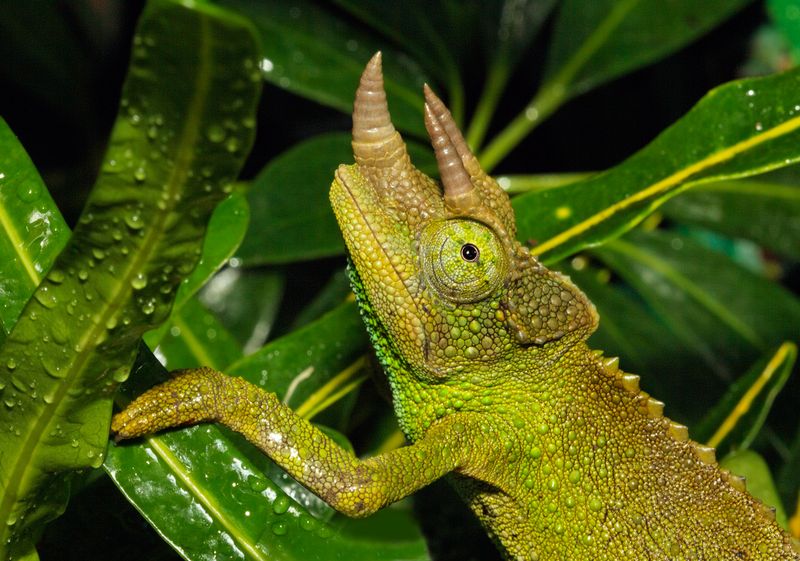
Distinct with its triceratops-like horns, Jackson’s Chameleon is an East African treasure. Its vibrant green and blue shades mimic the lush highland terrains it calls home. These horns are not just for show; they’re tools in social displays and rival contests.
As it perches on branches, its color shifts according to temperature and mood, a dynamic characteristic unique to chameleons. The Jackson’s Chameleon’s slow, deliberate movements are a dance of patience and precision, offering a glimpse into its thoughtful existence. Nature’s creativity shines brightly in this species.
Veiled Chameleon
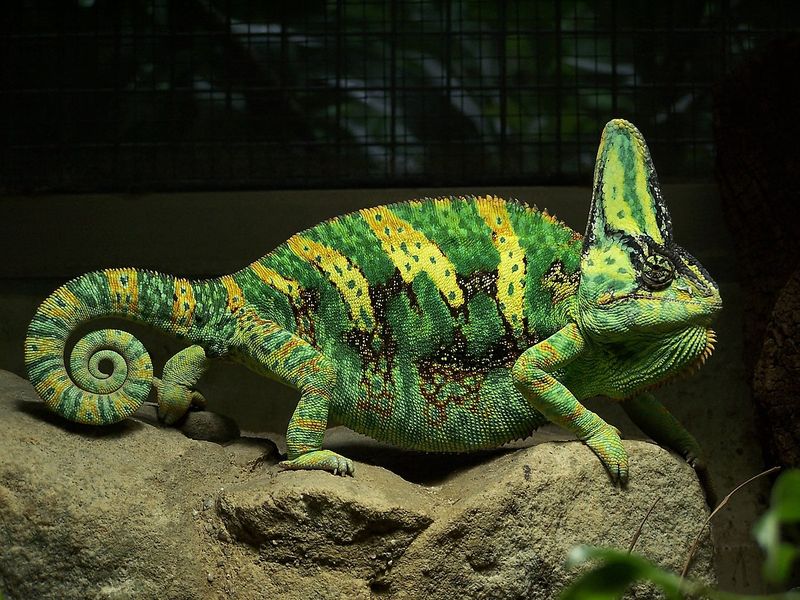
The Veiled Chameleon stands out with its striking green body adorned with yellow stripes. Native to the Arabian Peninsula, it’s perfectly adapted to arid environments. Its casque, a tall helmet-like structure, adds to its regal silhouette.
As it navigates the vegetation, its colors fluctuate with light and temperature, an adaptive marvel ensuring survival. The Veiled Chameleon’s gentle demeanor and striking look make it a beloved choice for reptile enthusiasts. Observing it in its natural habitat is akin to witnessing a living masterpiece of evolution.
Four-horned Chameleon

The Four-horned Chameleon is an enigma with its quartet of horns and mottled green-brown skin. Native to Cameroon, it resides in montane forests where its unique appearance provides perfect camouflage.
These horns, unlike any other, are believed to be a result of sexual selection, used by males in combative displays. As it basks in filtered sunlight, its skin adapts, blending effortlessly with the forest floor. The Four-horned Chameleon is a reminder of nature’s intricate designs and the wonders hidden within its depths.
Carpet Chameleon
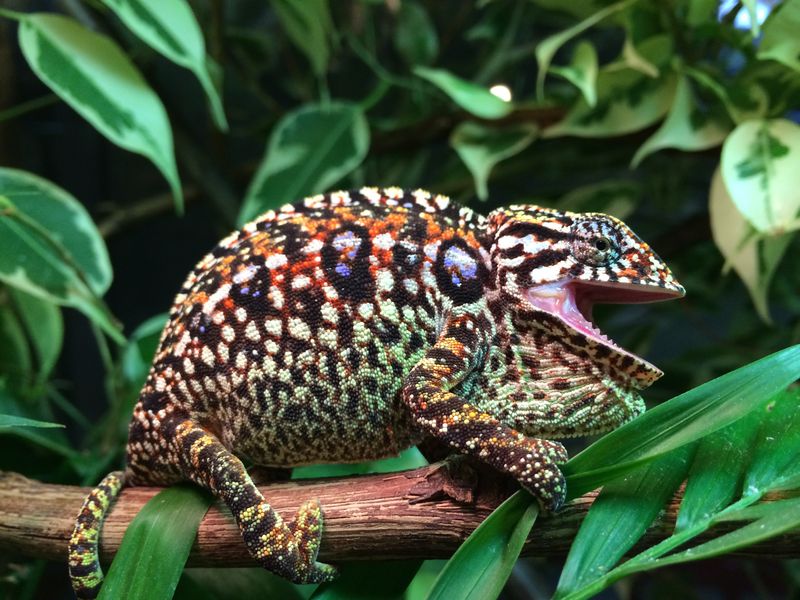
Vibrancy and versatility define the Carpet Chameleon. With a tapestry of colors ranging from green to orange, it’s like a living rainbow. Found across Madagascar, this species adapts effortlessly to different environments.
Its kaleidoscope of colors serves multiple purposes—communication, camouflage, and temperature regulation. Observing a Carpet Chameleon is akin to watching an artist at work, each color shift deliberate and meaningful. Its presence is a testament to the incredible diversity of Madagascar’s wildlife, making it a must-see for nature lovers.
Meller’s Chameleon
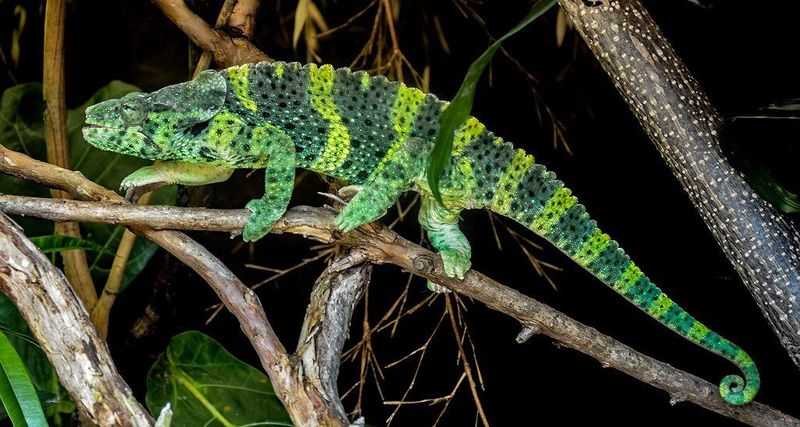
Often referred to as the giant one-horned chameleon, Meller’s Chameleon is a sight to behold. With its lengthy tail and body marked in green and white stripes, it seems like a creature from a fairy tale.
Native to East Africa, particularly Tanzania, its size and distinctive horn make it an imposing figure. As it basks in the sun, its colors shimmer, capturing the essence of the savannah. This chameleon not only captivates with its appearance but also tells a story of adaptation and survival in the wild.
Fischer’s Chameleon
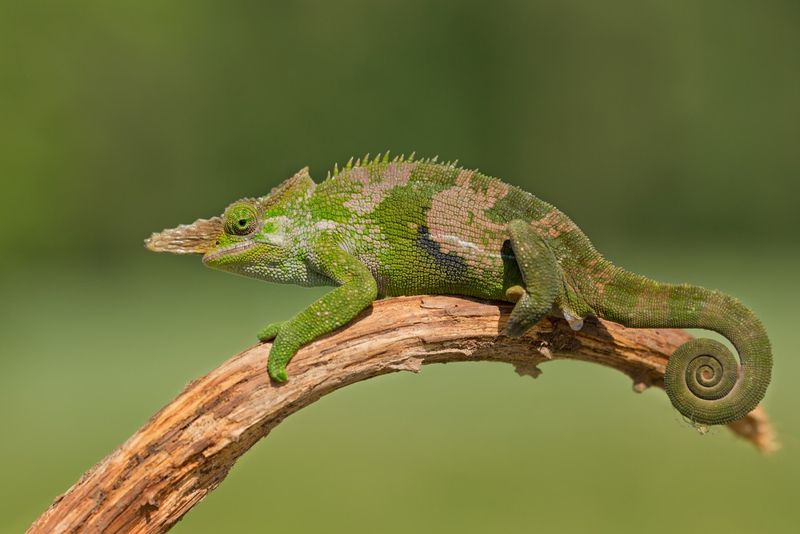
Fischer’s Chameleon, with its vivid green and blue hues, is a splendid example of nature’s artistry. Found in the forests of Kenya, its striking colors help it blend with the lush foliage, an essential survival trait.
Its elongated body and curious eyes make it a fascinating subject for wildlife enthusiasts. As it navigates its arboreal world, its skin shifts mesmerizingly, reflecting its moods and intentions. Fischer’s Chameleon is a reminder of the intricate beauty woven into the fabric of the natural world.
Namaqua Chameleon

In the scorching Namib Desert, the Namaqua Chameleon thrives against the odds. Its earthy tones of brown and grey perfectly mimic the desert landscape, a masterclass in camouflage.
This chameleon is a specialist in thermoregulation, altering its color to manage heat absorption. Observing it scuttle across the sand, you witness an evolutionary marvel adapted to extreme conditions. The Namaqua Chameleon is not just a survivor but a symbol of resilience in one of the world’s harshest climates.
Oustalet’s Chameleon

Oustalet’s Chameleon, or Malagasy Giant Chameleon, is a remarkable creature of Madagascar’s dry forests. Its dusty pink and green hues enable it to blend seamlessly into the woodland environment.
As the largest chameleon species, it commands attention with its size and grace. Watching it traverse the branches, its skin subtly shifts colors, a dance of adaptation and elegance. Oustalet’s Chameleon embodies the spirit of Madagascar—wild, vibrant, and endlessly fascinating.
Rhampholeon Chameleon

The Rhampholeon Chameleon, though diminutive in size, is big in character. Its small, brown body is perfectly adapted to life on the forest floor, where it blends seamlessly into the leaf litter.
Despite its size, it displays a fascinating array of behaviors, from rapid tongue flicks to complex color changes. Its understated beauty and adaptability make it a special find for those keen on discovering Madagascar’s hidden gems. The Rhampholeon Chameleon is a testament to the wonders waiting in the undergrowth.
Dwarf Fischer’s Chameleon

Small yet striking, the Dwarf Fischer’s Chameleon is a vibrant jewel of Tanzania. Its bright red and green colors make it a standout in its leafy home.
Despite its size, this chameleon displays a bold personality and intricate color patterns. Observing it in its natural habitat reveals its mastery over its environment—each movement purposeful and graceful. The Dwarf Fischer’s Chameleon is a reminder that big surprises often come in small packages.
Brookesia Micra
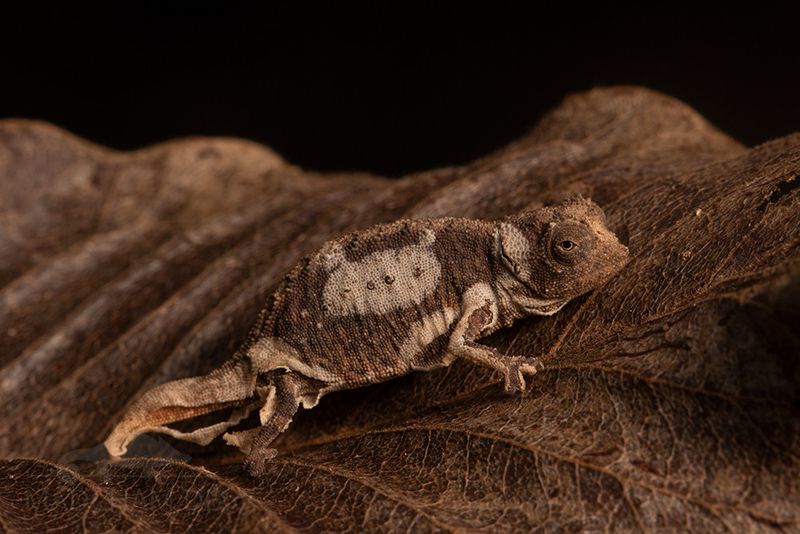
The Brookesia Micra, the world’s tiniest chameleon, fits snugly on a matchstick head. Found exclusively in Nosy Hara, Madagascar, it’s a marvel of miniature evolution.
Despite its size, it boasts a world of detail, from its intricate skin patterns to its agile movements. Watching this tiny creature navigate its forest floor habitat is a humbling experience, a reminder of nature’s ability to create wonders on any scale. The Brookesia Micra is a symbol of the delicate balance and diversity found in Madagascar.
Pygmy Chameleon
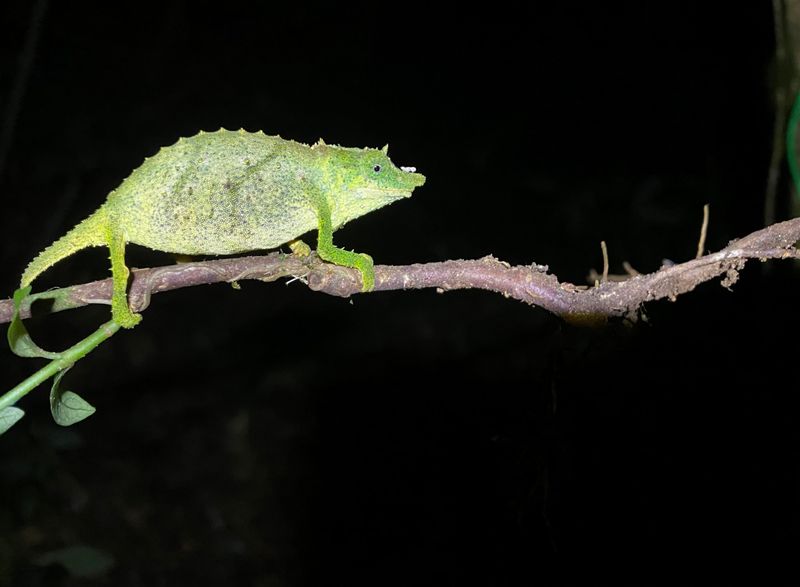
The Pygmy Chameleon is a master of disguise, its earth-toned body blending perfectly with the Tanzanian underbrush. Its small size and subtle coloration make it an elusive yet fascinating find.
Despite its unassuming appearance, it displays incredible adaptability and survival instincts. Observing a Pygmy Chameleon is like discovering a hidden treasure, each sighting a unique encounter with nature’s ingenuity. This chameleon exemplifies the understated beauty and complexity of life in the wild.
Tarzan Chameleon
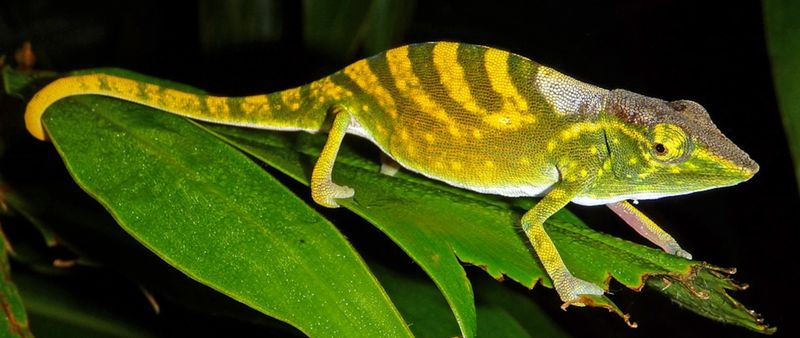
The Tarzan Chameleon is a rare gem in Madagascar’s rainforest, renowned for its striking green and blue hues. Its vibrant colors stand out amidst the dense foliage, a beacon of biodiversity.
This chameleon’s name pays homage to the adventurous spirit of its jungle home, where it swings from branches with grace. Watching a Tarzan Chameleon is an exploration of nature’s palette and a celebration of its boundless creativity.
Bearded Pygmy Chameleon

The Bearded Pygmy Chameleon is an understated marvel of the Tanzanian forest. Its earthy tones and delicate beard-like scales provide perfect camouflage amidst the canopy leaves.
Despite its small size, it is a resilient and adaptable creature, navigating the forest with remarkable agility. Watching it move among the branches is an exercise in patience and appreciation for nature’s subtleties. The Bearded Pygmy Chameleon is a gentle reminder of the intricate beauty hidden within the forest.
Labord’s Chameleon
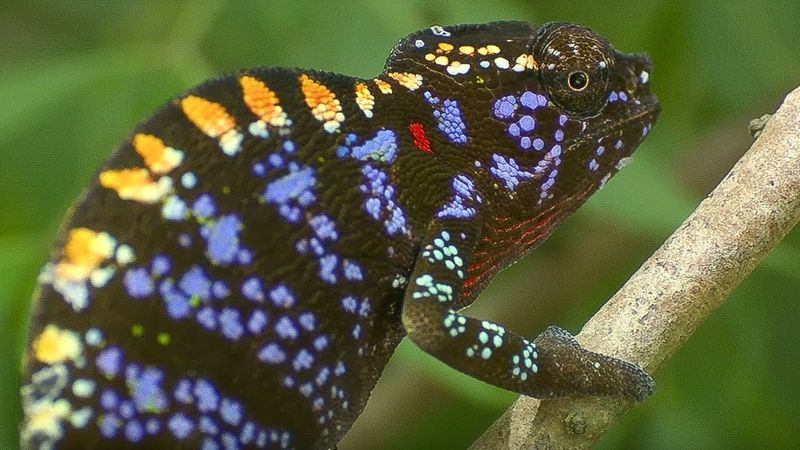
Ever heard of a chameleon that lives life in the fast lane? Meet Labord’s Chameleon, an offbeat marvel of nature. Sporting a dazzling array of orange, green, and blue hues, this chameleon is a true spectacle. Incredibly, it spends most of its life as an egg, emerging for only four to five months to experience the world.
During this brief adult phase, Labord’s Chameleons engage in a whirlwind of activity – from mating to laying eggs – before their cycle ends. This frantic, colorful burst of life adds an extraordinary chapter to Madagascar’s rich tapestry of biodiversity.
Interestingly, Labord’s Chameleon’s lifespan strategy is unique among vertebrates, drawing curiosity and admiration from researchers worldwide. It’s a brilliant example of nature’s ingenuity, showcasing an unforgettable spectacle in the chameleon family.

